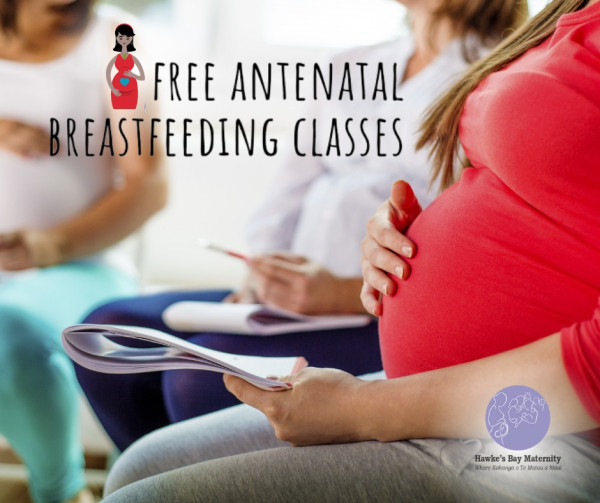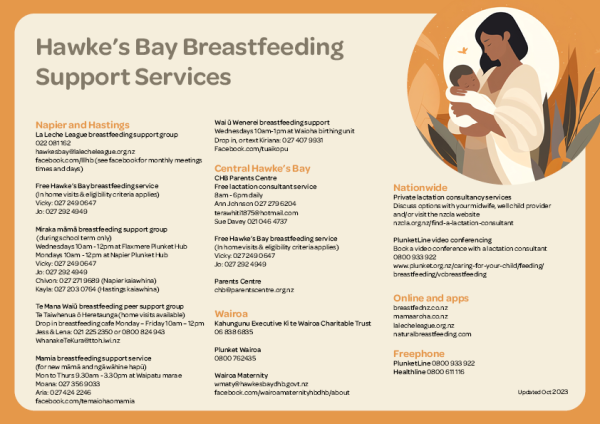Breastfeeding
Breastfeeding provides lifelong health benefits for both mothers and babies and is a free, fast food!
For many women breastfeeding is simple, but as with anything it becomes easier with practice. Your Lead Maternity Carer (LMC) is there to help you get started and until six weeks after your baby is born, when your Well Child provider takes over. Talk to your LMC if you have any specific concerns or questions. If you stay in hospital, there are nurses and midwives who can help.
On this page:
Antenatal breastfeeding classes
Free antenatal breastfeeding classes are offered at Hawke's Bay Hospital in Hastings on the first Monday of every month (unless that Monday is a public holiday, in which case the class will be on the following Monday). The classes are held in the Education Centre (nearest the Emergency Department entrance on Canning Road) from 5.30pm-7.30pm.

La Leche League
La Leche League breastfeeding peer counsellors. Email hawkesbay@lalecheleague.org.nz or message on Facebook: facebook.com/LLLHB
![]()
Central Hawke's Bay Parents' Centre
CHB Parents Centre offers the community a free and professional service with a Lactation Consultant. Contact Ann Johnson by text 027 279 6204 or Sue Davey 021 046 4737 between 9am and 6pm.
![]()
Wairoa
Kahungunu Executive. Ph 06 838 6835
![]()
Plunket 06 870 5009
![]()
24/7 services
Plunket Line – Ph 0800 933 922

Let your support network know
Most women will be able to breastfeed without special preparation, but make sure you let your partner and family know that you will be breastfeeding so they can support you.
Expressing colostrum
You may wish to express colostrum before you give birth.
What is it? Colostrum is the first form of milk produced, just before and immediately after birth.
Why is it good? Colostrum is like a superfood for your baby. It contains antibodies to protect your baby against disease, and it may help keep your baby’s blood sugar levels stable. Newborn babies have small digestive systems, and colostrum delivers nutrients in a very concentrated form. It has a mild laxative effect, which encourages the passing of the baby's first stool, which in turn helps prevent jaundice.
When do I do it? Check with your LMC; but generally you can try expressing colostrum by hand from 36 weeks of pregnancy.
How do I do it? See the section below on ‘Expressing by hand’.
If you have expressed colostrum before birth, try to remember to bring your frozen colostrum to the hospital!

Expressing milk
Expressing milk means squeezing milk out of your breast. You would do this if you are separated from your baby for any reason.
If you find you need to express breastmilk you can do this by:
- manual pump
- electric Pump
- hand
Buy or hire an electric pump from a pharmacy, baby shop or lactation consultant. If you think your milk supply is getting low breastfeed and express more often.
Cleaning
Wash and rinse pumps and containers in very hot water.
If you baby is under three months old, sterilise pumps and containers by:
- boiling in water for five minutes or
- soaking in a sterilising solutions for one hour or
- some pumps can be steam sterilised in a microwave.
Returning to work
Many mums go back to work and keep breastfeeding their babies. You can continue to breastfeed by:
- expressing and storing breast milk so that someone else can feed your baby
- having your baby looked after near your work, so that you can go and feed them
- having your baby with you at work
- having someone bring your baby to you at work for feeds.
Talk to your whānau and friends to see how they can help. Your midwife or nurse can give you advice.
Talk to your employer
As soon as you know you’ll be returning to work, talk to your employer about breastfeeding. (You could even do this when you’re planning maternity leave.) By law, your employer must give you unpaid breaks to breastfeed your baby or express milk at work, and must provide you with facilities to do this. Explain to your employer that to breastfeed you’ll need a:
- clean, quiet, warm and private room or space
- low, comfortable chair.
Explain that to express breast milk you may also need a:
- private room with a door that can be locked (if possible) – you can put a ‘busy’ sign on the door if the room can’t be locked
- basin to wash your hands and equipment
- fridge in which to store the milk, or a chilly bin with ice-packs
- table
- power point if you’re using an electric breast pump
- clean place to store equipment (eg, breast pump).
| Central Hawke's Bay Parents Centre | |
| |
La Leche League Hawke's Bay |
| |
Breastfeeding page |
| |
Plunket Hawke's Bay webpage |
| |
Tamariki Ora Well Child provider |





